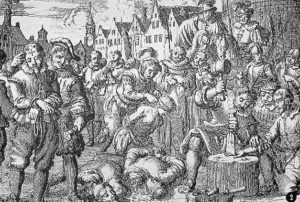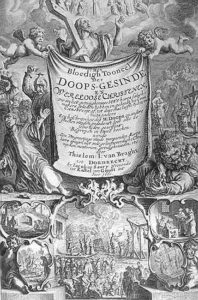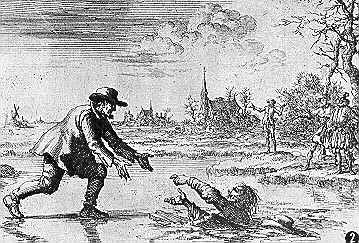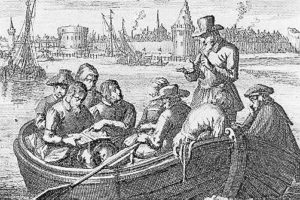History
The Mennonite story is about a people on the move. From their Anabaptist beginnings in Switzerland, Holland, and Germany, Mennonites have now spread virtually all around the world. But how did this movement start? Why are there so many different groups? Well, the best place to start is at the beginning...
Mennonites trace their historical roots back to the European Reformation in the early 1500s. During this tumultuous period many groups emerged from the Roman Catholic church. The members of one group disagreed with baptizing children. They believed that entering the Christian church should be one’s own decision, and so adults, not children, should receive baptism. They began to baptize adults, against the strict orders of official church leaders.
This group was originally known as the “re-baptizers” or “Anabaptists,” since the adults receiving baptism had already been baptized as children. Although still a Christian group, the Anabaptists were clearly distinct from both the traditional Roman Catholic church, as well as from other Protestant reformers. As a result, they were seen with suspicion from both sides, and were sometimes even killed for their beliefs.
As time went on, the Anabaptist movement continued to grow. Later in the 1500s, Menno Simons became an influential leader of the group in Holland and Northern Germany. As a result, people in this community came to be called “Mennists.” Later, after contact with English speakers, these people and related groups became known as “Mennonites.”
Reformation
95 Thesis
On October 31, 1517, a Roman Catholic monk and Bible scholar named Martin Luther posted several pages on the main door of a church in Wittenberg, Germany. Luther’s “95 Theses,” as these pages were later called, questioned some of the practices of the church.
Although the church had changed its practices before, Luther’s comments were especially hard to take. By 1520 the Catholic church had begun proceedings to excommunicate Luther. After refusing to “take back” his conclusions, Luther was kicked out of the church in 1521.
Reformation Begins
What began as a discussion between scholars began to have effects beyond anyone’s imagination – the Reformation had begun. Within 5 years several princes had splintered off from the Roman Catholic church, and relations between them and other rulers who stayed in the traditional church became quite hostile.
Although the vast majority of Europe remained Catholic, reform movements were beginning to show. Parts of Germany were under Martin Luther’s influence, while reform in the region of Zurich, Switzerland was guided by Huldrych Zwingli. Since these movements came out of Luther’s “protest” towards the traditional church, the emerging church groups have become known as Protestant churches.
Another major change during this time was that, in 1521, Luther translated the New Testament into German for the first time. Although less than 10% of people could read, this made it possible for people to hear Bible stories and passages in their own language. News, pamphlets, and sketches, as well as religious and political cartoons circulated through the countryside. New ideas were being discussed in the houses, taverns, and roads of Europe, sometimes as a result of people’s own reading and interpretation of the Bible. Religion was a very hot topic.
This was the situation when the “radical Anabaptists” appeared on the scene.
Created 1998 by Derek Suderman
Early Anabaptists
Martin Luther set many events in motion. He began a period when people heard (and some read) the Bible in their own language. As a result, many groups began to interpret the Bible for themselves, searching for the meaning of these stories for their own lives and situations. This led to a questioning of traditions, and sometimes a clamour for change – a period which is known as the Reformation.
Reform in Zurich
Huldrych Zwingli was the reformer guiding the process of change in the city of Zurich, Switzerland. Like Martin Luther, Zwingli believed that the church should use the Bible rather than church tradition as its guide. Although he was supported by most people in the area, some thought that he was moving too slowly and not making enough changes. When Zwingli gave the town council authority to make decisions about the church, some people disagreed strongly.
Conrad Grebel was one of these people. Early on he had been very excited about the changes that Zwingli was making, and supported him fully; by 1523 some doubts began to emerge. Grebel did not think that the reforms were going far enough, and it was taking longer than he had hoped. He and some of his friends wanted to do away with anything that was not described in the Bible. Zwingli’s decision regarding the relationship between town council and the church was the last straw.
First Adult Re-Baptism
Sometime towards the end of January, 1525, Conrad Grebel and a small group met for Bible study in a house in Zurich. During the meeting George Blaurock asked Grebel to baptize him, after which Blaurock baptized several others. The town council found out and made further gatherings of this group illegal. Since these people had already been baptized as children, they were nicknamed “rebaptizers” or “Anabaptists.”
This event is widely recognized as the beginning of the Anabaptist movement. Over the next ten years or so, other groups began to pop up in parts of Germany and Holland who also baptized adults. Although there was some contact between these groups, we are still not sure whether they began separately or because of connections with the group from Switzerland.
First Execution
Felix Manz was one of the people baptized by Blaurock at this early meeting. Like some of the others, he was constantly being arrested and spending time in prison. During one of these periods in prison he wrote “I Sing with Exultation,” a song which remains part of the Mennonite tradition. On January 5, 1527 he was taken to the Limmat River, tied to a pole, and drowned – the first Anabaptist executed for his faith by Protestant authorities.
Created 1998 by Derek Suderman
Persecutions
Being an Anabaptist in the 16th century was not an easy task. From their beginnings in 1525 until the end of the century, this group was severely persecuted for their beliefs. Both women and men were questioned, tried, severely tortured, and even executed – an estimated 5,000 Anabaptists lost their lives during this period.
Again in the 17th century the Anabaptists were targets of persecution as tension increased between Catholic and Protestant leaders. All of Europe was then deeply affected by the “Thirty Years War” between these two groups in 1618-1648. The Martyr’s Mirror proved important in preserving the memory of this time of persecution for those of Anabaptist background.
Martyr's Mirror
The Martyr’s Mirror, first published in Holland in 1660, tells hundreds of stories of how different Christians were killed for their beliefs (martyred). These accounts, taken from the 1st century until the 17th, emphasizes the suffering of the Anabaptists and fills over 1000 pages. These stories served as a challenge, example, and source of courage for others who wanted to follow Jesus in their life, and even death. Many stories are also accompanied by drawings depicting the events. Perhaps the most famous account is that of Dirk Willems.
This kind of severe persecution was not uncommon. An assortment of torture techniques were used in order to produce as much pain as possible. Finally, people were killed in many ways: beheaded, drowned, “burned at the stake,” buried alive, and more. A feature movie was made about the life of Michael Sattler, another of these Anabaptist martyrs. Titled “The Radicals,” it follows Sattler from his life as a monk in the Catholic church, to his involvement in Anabaptism, and finally his execution.
Anabaptists Go "Underground"
The very real threat of persecution caused the Anabaptists to go “Underground,” meeting secretly in fields, barns, or wherever they could. One of these sites used by 16th century Anabaptists in Switzerland is still referred to as the “Cave of the Anabaptists.” Although it began as an urban movement in Switzerland and Southern Germany, persecution drove Anabaptism into the country in less than 5 years. In Holland, however, cities continued to be important sites for Anabaptists. As we shall see, Anabaptists (and later Mennonites) have often moved so that they could practice their religious beliefs openly and without being punished for them.
Created 1998 by Derek Suderman



In the winter of 1569 Dirk Willems was fleeing on foot when he crossed over a stream. The man who was trying to catch him fell through the ice, and was in danger of drowning. Despite the danger to his own life, Dirk Willems returned to pull the man out of the water. After being rescued, his pursuer arrested him and took him to the authorities. Willems was tied to a wooden pole, set on fire, and burned to death.

